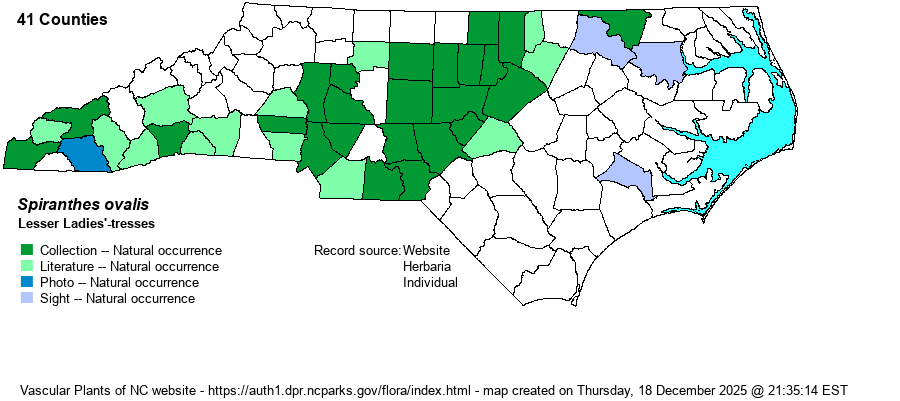| Author | Lindley | |
| Distribution | This is one of the few NC orchids whose range is primarily in the Piedmont. This species occurs mostly in the eastern 35-40% of the Piedmont, but it does occur sparingly in the southwestern Piedmont, a few Coastal Plain counties, and in the southern Mountain counties. Specimens at SERNEC from Henderson and Swain counties lack images.
This species has a general Eastern range, found north to PA and IA, south to northern FL and eastern TX. It is not common anywhere, and most states have records for fewer than half of its counties. | |
| Abundance | Uncommon in the eastern third to 40% of the Piedmont, but rather rare outside this region -- into a few areas of the Coastal Plain the southwestern Piedmont, and the southern Mountains. The species is not nearly as rare as the NC NHP's State Rank of S2S3, and the website editors suggest at least S3. | |
| Habitat | This is one of a very few Spiranthes species that requires strong shade of forests. It prefers moist soil, and it is most prevalent in bottomlands, rich woods, near wooded streamsides, and in drier swamps. It can occur in upland forests, but mostly where rich or moist. | |
| Phenology | This is a fall-blooming species, mainly in September and October, rarely into November. It fruits shortly after flowering. | |
| Identification | This is a slender Spiranthes, with a stem growing mainly 1 foot or less tall. It has a dense and very narrowly ovate to oval flower cluster, of very small white flowers in several spiral rows. The flowers have the lips white on top. The inflorescence is usually only 2-3 inches tall and barely 1/2-inch wide, and thus a person can easily walk past a blooming plant in the shade of a forest if not carefully watching. Also, the species does not occur in colonies, so normally only a few scattered individuals are seen. The species should be readily identified by its fall blooming period, its rather small but narrowly ovate inflorescence, and especially in its deep shade habitat of rich or moist forests. Most biologists do not spend much time in fall walking the interior of moist forests looking for flowering species, as wooded borders, fields, powerline clearings, and other open or semi-open habitats are where most species are in bloom in the fall season. | |
| Taxonomic Comments | This has always been a valid species, but there are several varieties for it. The only one in NC is S. ovalis var. erostellata.
| |
| Other Common Name(s) | Oval Ladies'-tresses, October Ladies'-tresses | |
| State Rank | S2S3 [S3] | |
| Global Rank | G5? | |
| State Status | | |
| US Status | | |
| USACE-agcp | FAC link |
| USACE-emp | FAC link |

